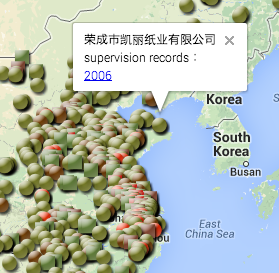- Title Page
- Introduction
- Becoming an environmentalist
- Obstacles to enforcement
- We must fight with data
- China Pollution Maps launched
- Taking on supply chains
- Pollution Information Transparency Index
- Tainted milk, heavy metalsand more
- Poison Apple
- Green investment
- Blueprint for blue skies
- Real-time data begins
- Real-time dilemma
- Appendix 1
- Appendix 2
- Appendix 3
- Appendix 4
China Pollution Maps launched
In May 2006, Ma Jun founded the non-profit Institute of Public and Environmental Affairs in Beijing, with just two staffers. (The number would grow to eight by 2010, and double again by late 2013.) His mission was to do something with his research into water mismanagement that would motivate a public response. First, he had to build a database. IPE used public records, mainly from EPBs, as well as reports published in official media. None was a “state secret.” Three kinds of information, dating back to 2004, went into the database:
Environmental quality indicators —levels of specific greenhouse gases and pollutants in the air and water, by city, province and river basin
Emissions data —aggregate levels of industrial and domestic discharge of specific pollutants, by city, province and river basin
Environmental supervision records —details of incidents in which companies had been fined or cited by environmental authorities
In September 2006, IPE released its first product, the so-called China Water Pollution Map. Fifteen months later, in December 2007, it launched a companion China Air Pollution Map. Though simple in concept and design, these became transformative tools in China’s burgeoning environmental movement. Having the information in one place, in a consistent format and tied to a map made it more useful. With the tool, anyone—citizen, reporter, blogger, activist, regulator, or concerned company—could view pollution levels on national or provincial levels, or across 300 cities or 11 river basins. [8] Users could compare year-on-year trends and see how industrial and domestic discharge levels were changing.

A view of an IPE pollution map
Using the supervision records to single out individual violators won IPE much attention. Its database included water pollution citations for 2,500 enterprises and air pollution citations for 4,000. [9] By seeing where the violators were located, people could start to link high pollution levels in those areas to the behavior of individual factories. IPE also added Google Earth images, allowing users to see what the factories looked like from above—how large, how sprawling, how near to waterways—rather than merely as dots on a map.
Approval . The state-run Xinhua News Agency gave the maps approving coverage and noted that IPE had “blacklisted” the violating companies. [10] This suggested that the government saw Ma’s work not as a threat to its authority, but as a potential asset. The maps showcased the EPBs’ efforts to hold polluters accountable, and could help SEPA apply pressure to local officials to deal more severely with polluters. SEPA deputy director Zhou Jian went so far as to laud the burgeoning role of organizations such as IPE in supporting regulators. “NGOs have close ties with people and can mobilize the public to participate in environmental protection activities,” he said in October 2007. “NGOs have become an important social force in promoting China’s environmental protection and acted as advisers to the government.” [11] At the time, there were 2,700 registered environmental groups in China. [12]
Without SEPA’s support, the NGOs would have been unable to operate. But Ma recalls it took patient effort in IPE’s early years to convince officials, especially local environmental authorities, that his organization was not trying to interfere with their work or punish commercial enterprises. “We carry on this transparency work only for environmental protection, for pollution reduction. It’s not about any other thing. It’s totally nonprofit,” he says. “I think it’s very important for the EPBs to understand this point.”
[8] To explore the interactive pollution maps in their current form, visit: http://www.ipe.org.cn/En/pollution/sources.aspx?mode=0
[9] By 2013, there were 150,000 supervision records in the database.
[10] “Chinese NGO blacklists 4,000 companies for bad air pollution record,” People’s Daily Online , December 13, 2007. See: http://english.people.com.cn/90001/90776/6320616.html (accessed 16 July 2014).
[11] “Chinese Government Praises NGOs’ role in Making Environment-Friendly Policies,” People’s Daily Online ,31 October 2007, http://english.people.com.cn/90001/90776/90882/6293643.html (accessed 16 July 2014).
[12]
Thousands more groups operated unofficially. For a history of environmental NGOs in China, including their evolving tactics and relations with government, refer to:
Judith Shapiro, “The Evolving Tactics of China’s Green Movement,”
Current History
(September 2013).